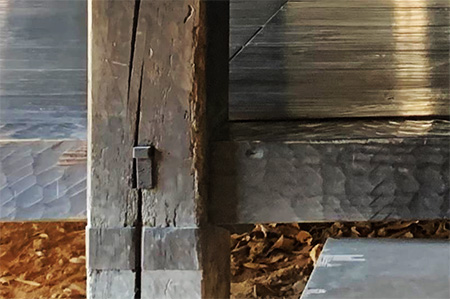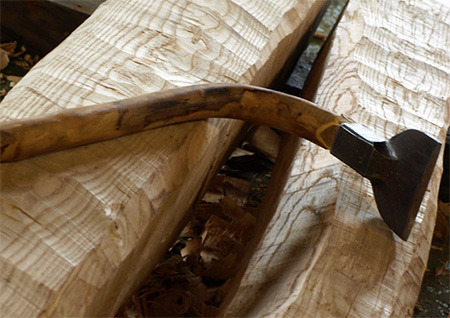

上の写真は神奈川の古民家・旧岩澤家住宅土間から床上接続部分。
この床の横架材には刻み跡も楽しい、釿(ちょうな)仕上げが見えている。
この建物は復元ですが材はできるだけ既存材を使ったとされる。
ふしぎに柱を挟んで左右で仕上げの調子が違う。どっちかが新材なのかも。
どうも左側は「似せました」感が感じられるかなぁ・・・。
下の写真はWEBで見つけた加工過程と釿本体。
人類と木工の付き合いはそれこそ石器時代にまでさかのぼる。
アフリカから出てほぼすべての大陸世界に進出できたのには、
船の加工技術が随伴したことがあきらかですね。
アジア、それも台湾からと特定された最初期日本列島移住も、
丸木舟を加工して出航しただろうことが歴史発掘されてきている。
石器時代のこと。(その状況もブログで触れたことがあります)
木を切って有用なものを作る初源では、まずは「船大工」技術が先行し、
その後「家大工」技術が伸展していったというように言われる。
石器段階では人類は定住していない。移動採集生活としては
船の方がより重要なインフラであって、一時的に暮らす場所は洞穴とか、
簡易キャンプ的な暮らしようだったと言われている。
囲炉裏(茶の間?)起源はあきらかにキャンプ生活に見いだせる。
で、その船大工技術として「丸太をくりぬく」という重要工程があり
そこで石器が進化して最初期ころに釿(ちょうな)が開発された。
木を切る石器斧とほぼ同時に石器釿(ちょうな)も生み出されたのだと。
現代木工技術ではプレーナー加工でカンナ仕上げのように
平滑面がいとも簡単に仕上げられるのですが、
それが常識になってくると今度は手仕事の「風合い」のようなものが
希少価値を持って迫ってくるようになる。
釿(ちょうな)仕上げなどはその最たるもの。
その独特の風合いがいかにも手仕事感を感じさせてくれます。
一般的な住宅ではこういう仕上げ方法を望んでも大工仕事からは
ほぼ絶滅危惧種のようなものではないかと思います。
新築現場でこういう加工ぶりはほとんど目にすることがない。
話はズレますが、最近「プロ施主」というコトバを耳にします。
Youtube動画などを見まくってヘタなプロの知識不足を突くそうです。
高断熱技術発祥の寒冷地ではそういう傾向は見られなかったのですが、
最近のWEBでの情報受発信社会では、そういうことも起こってくる。
住宅は愛着を持って永く住み暮らすためのもの。
家を建てたいと希望されるみなさんにはぜひこういう古民家などでの
風合い、雰囲気の部分にも目を向けていただければと思います。
English version⬇
[Texture of Adze processing / Good Japanese house ㉙-8]
The photo above is the part above the floor from the dirt floor of the old Iwasawa family house in Kanagawa.
You can see the adze finish on the horizontal material of this floor, which has fun notches.
This building has been restored, but it is said that the existing materials were used as much as possible.
The finish is different on the left and right with the pillar in mystery. Either one may be a new material.
The photo below shows the processing process and the main body of the adze found on the WEB.
The relationship between humankind and woodwork dates back to the Stone Age.
The reason why I left Africa and traversed almost all the continental world
It is clear that the processing technology of the ship was accompanied.
The earliest migration to the Japanese archipelago, identified as from Asia and Taiwan,
It has been unearthed in history that the dugout canoe would have been processed and set sail.
(I have mentioned the situation on my blog)
At the first source of cutting wood to make useful things, the “ship carpenter” technology preceded.
After that, it is said that the “house carpenter” technology developed.
Mankind has not settled at the stone tool stage. As a mobile collection life in the first stage
Ships are a more important infrastructure, and temporary places to live are in caves.
It is said that it was like living in a simple camp.
The origin of the hearth can be clearly found in the camping life.
So, as such a ship carpenter’s technique, there is an important process called “hollowing out”.
There, stone tools evolved, and the adze was developed around the earliest days.
Almost at the same time as the ax that cuts the tree, an adze was also created.
With modern woodworking technology, planer processing makes it smooth like a plane finish.
It ’s very easy to finish,
When it becomes common sense, this time something like the “texture” of handicrafts
It comes to approach with a rare value.
The adze finish is the best of all,
Its unique texture makes you feel like handicrafts.
In a typical house, even if you want this kind of finishing method, from carpentry
I think it’s almost like an endangered species.
This kind of processing is rarely seen at new construction sites.
On the other hand, recently I’ve heard the word “professional owner”.
It seems that you will find a lack of professional knowledge by looking around Youtube videos.
I didn’t see such a tendency in the cold regions where high insulation technology originated.
In the recent society of information transmission and reception on the WEB, such a thing happens.
Housing is for living with attachment for a long time.
For those who want to build a house, such an old folk house
I would like you to pay attention to the texture and atmosphere.
Posted on 5月 9th, 2021 by 三木 奎吾
Filed under: 住宅マーケティング, 住宅性能・設備







コメントを投稿
「※誹謗中傷や、悪意のある書き込み、営利目的などのコメントを防ぐために、投稿された全てのコメントは一時的に保留されますのでご了承ください。」
You must be logged in to post a comment.